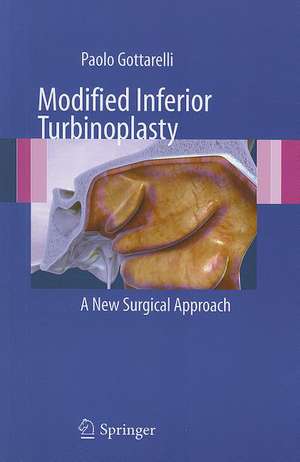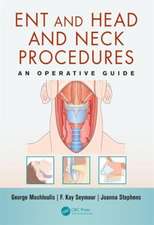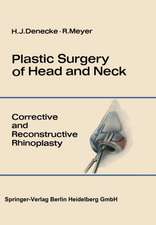Modified Inferior Turbinoplasty: A new surgical approach
Autor Paolo Gottarellien Limba Engleză Paperback – 11 ian 2012
Preț: 424.15 lei
Preț vechi: 446.47 lei
-5% Nou
Puncte Express: 636
Preț estimativ în valută:
81.16€ • 84.97$ • 67.16£
81.16€ • 84.97$ • 67.16£
Carte disponibilă
Livrare economică 15-29 martie
Preluare comenzi: 021 569.72.76
Specificații
ISBN-13: 9788847024410
ISBN-10: 8847024412
Pagini: 86
Ilustrații: XIV, 84 p.
Dimensiuni: 155 x 235 x 8 mm
Greutate: 0.23 kg
Ediția:2012
Editura: Springer
Colecția Springer
Locul publicării:Milano, Italy
ISBN-10: 8847024412
Pagini: 86
Ilustrații: XIV, 84 p.
Dimensiuni: 155 x 235 x 8 mm
Greutate: 0.23 kg
Ediția:2012
Editura: Springer
Colecția Springer
Locul publicării:Milano, Italy
Public țintă
Professional/practitionerCuprins
The History of Rhinoplasty.- Well-being and Respiration.- Nasal Anatomy and Function.- The Inferior Turbinates.- Diagnosis.- How we attained Modified Inferior Turbinoplasty.- The New Modified Inferior Turbinoplasty.- Post-traumatic Hump Nose.- The Modified Inferior Turbinoplasty, Step by Step.- The Concept of "Respiratory Symmetry".- The Control of Relapses in Septal Deviations.- Conclusions.
Notă biografică
Paolo Gottarelli was born in Bologna, Italy in 1952. He obtained his MD at the University of Bologna in 1978 and subsequently specialized in plastic surgery and odontostomatology. In 1989 he introduced in Italy the innovative surgical technique of vector tip rhinoplasty, developed by John B. Tebbetts in Dallas. In 1994 Dr. Gottarelli was awarded first prize at the National Congress of Plastic Videosurgery (Italian Hospital Surgeons Association). In 1997 he developed modified inferior turbinoplasty, and the technique has since been employed in 4000 reported cases. From 1998 onward, he has frequently been invited to give lessons on MIT at congresses in Italy and elsewhere around the world (e.g., Trieste, Dubrovnik, Barcelona, Guadalajara). He has also given university courses in Ferrara, Bologna, and Urbino. Since 1991 Dr. Gottarelli has been interested in the applications of computer technologies to plastic surgery.
Textul de pe ultima copertă
Humans can resist 40 days without eating and 4 days without drinking, but only 4 minutes without breathing: this tells us much about its fundamental importance. Restoring an efficient nasal function is a very important – and in some cases crucial – issue.
This book describes an innovative surgical technique called modified inferior turbinoplasty, which offers an excellent solution to the problems associated with the lower turbinate hypertrophy. A turbinate (or nasal concha) is a long, narrow, curled bone shelf that protrudes into the breathing passage of the nose. Most surgical interventions treat only the soft parts of hypertrophic turbinates and often lead to relapse. With this technique, in contrast, all anatomic parts of the turbinate are treated and swabs in the nose are completely avoided, which is fundamental for patients well-being and a quicker recovery.
The book will be very useful for othorinolaryngologists, plastic surgeons, endoscopic and maxillofacial surgeons.
This book describes an innovative surgical technique called modified inferior turbinoplasty, which offers an excellent solution to the problems associated with the lower turbinate hypertrophy. A turbinate (or nasal concha) is a long, narrow, curled bone shelf that protrudes into the breathing passage of the nose. Most surgical interventions treat only the soft parts of hypertrophic turbinates and often lead to relapse. With this technique, in contrast, all anatomic parts of the turbinate are treated and swabs in the nose are completely avoided, which is fundamental for patients well-being and a quicker recovery.
The book will be very useful for othorinolaryngologists, plastic surgeons, endoscopic and maxillofacial surgeons.
Caracteristici
Presents in detail an effective operative technique for inferior turbinate hypertrophy Will help to solve a knotty problem in nasal surgery Explains the clear advantages over current procedures, including avoidance of relapse







